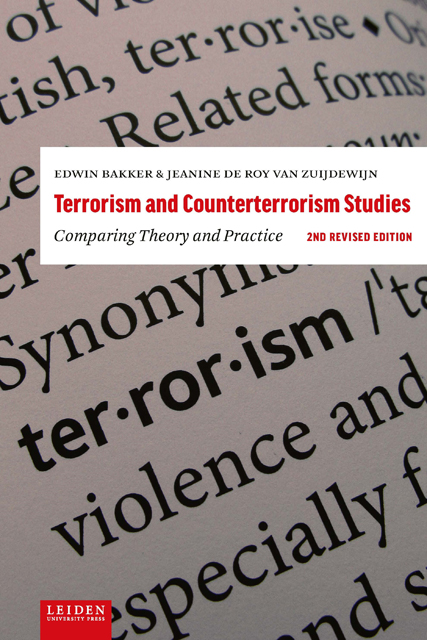Book contents
- Frontmatter
- Contents
- List of boxes & figures
- Preface
- About the authors
- Acknowledgements
- 1 Definition and nature of terrorism
- 2 History of terrorism
- 3 Terrorism studies
- 4 Assumptions about terrorism
- 5 Assumptions about counterterrorism
- 6 Dealing with the impact of terrorism
- 7 Trends and developments in (counter)terrorism and a future research agenda
- Index
5 - Assumptions about counterterrorism
Published online by Cambridge University Press: 12 January 2023
- Frontmatter
- Contents
- List of boxes & figures
- Preface
- About the authors
- Acknowledgements
- 1 Definition and nature of terrorism
- 2 History of terrorism
- 3 Terrorism studies
- 4 Assumptions about terrorism
- 5 Assumptions about counterterrorism
- 6 Dealing with the impact of terrorism
- 7 Trends and developments in (counter)terrorism and a future research agenda
- Index
Summary
Introduction
In the previous chapter we analysed five assumptions about terrorism. In this chapter we will investigate five popular assumptions about counterterrorism we consider interesting either because they are challenged or because of the opposite: they are considered true and constitute the basis for policy-making. As witnessed in the previous chapters, terrorism is a dynamic phenomenon and subject to continuous change, which means that theories and hypotheses regarding this phenomenon and the policies for dealing with it need to be regularly evaluated and possibly revised. This also holds for the following assumptions about counterterrorism which we will investigate in this chapter:
1. Profiling works.
2. Deradicalisation of terrorists is possible.
3. Decapitation of terrorist organisations works.
4. Terrorism cannot be defeated.
5. Terrorism can best be dealt with by way of a holistic or wide approach.
But before we move on to these assumptions, we first have to define the term ‘counterterrorism’. What exactly do we mean by this? Basically it refers to actions and policies to deal with the phenomenon of terrorism. That concept was discussed in detail in the first three chapters of this textbook. From that discussion we learned that there is no universally accepted definition of terrorism and that its meaning is to some extent a matter of personal opinion. Similarly, there are different opinions about counterterrorism. In this chapter we simply refer to ‘counterterrorism’ as a set of measures and activities that are designed to prevent terrorism or react to terrorism.
Assumption one: Pro_ling works
As discussed in chapter 3, one of the major difficulties when researching terrorism is its secretive nature. This is a challenge not only to academics, but also to policy-makers in the field of counterterrorism. Obviously, they would like to discover terrorists before they engage in terrorist activities. This is, of course, very difficult and the comparison with the proverbial finding of a needle in the haystack has often been made. Nonetheless, there have been several successful attempts to recognise a terrorist based on certain clues or signs – in most cases this related to ‘suspicious’ behaviour, which resulted in foiled terrorist plots (see box 5.01).
- Type
- Chapter
- Information
- Terrorism and Counterterrorism StudiesComparing Theory and Practice, pp. 145 - 200Publisher: Amsterdam University PressPrint publication year: 2022



